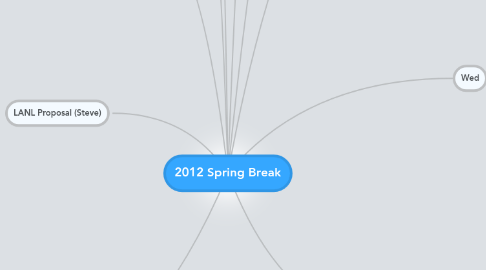
1. Shotgun DNA Maping
1.1. Things to do
1.1.1. Tons of Richard Suggestions (OWW / Private wiki)
1.1.1.1. Biggest thing is to make simulated data from random (or special) sequences and see how well SDM works. Probably like 4 more graphs
2. Kinesin Modeling Paper
3. LANL Proposal (Steve)
4. Image analysis growth rate
4.1. Modify Haiqing software
5. Image analysis Europe
5.1. Probably not do-able this week
5.2. Exactly synergistic with UC-Santa Cruz (Saxton)
5.2.1. Images are better (fly egg cytoplasm)
6. Tenure benefits
6.1. Accepted paper (can't see a route to this this week)
6.2. Submitted revisions
6.2.1. Kinesin modeling paper
6.2.1.1. Requires lots of reading
6.2.1.2. Not too much programming, but re-running simulations, making graphs
6.2.1.3. Middle author for Anthony
6.3. Submitted first drafts
6.3.1. Andy Isotope Paper
6.3.1.1. A bit of work for Steve
6.3.2. SDM
6.3.2.1. Requires some more programming
6.3.2.2. If lots of new programming and graphs (maybe some of our data), then first author for Anthony)
6.3.2.3. New node
6.3.3. Crumley
6.3.3.1. Notebook / Figshare
7. Monday
7.1. Find Richard's SDM comments
7.1.1. Make list of figures/experiments to make
7.2. Find code for Haiqing
7.2.1. Get code running
7.3. Find Larry / Anthony SDM code
7.3.1. Get code running
8. Tuesday
8.1. Continue with Richard comments
8.2. Collaborate on SDM software
8.2.1. Find important sequences
8.2.1.1. These are probably in Anthony OWW notebook
8.2.1.1.1. Once found, SJK put into github repository as sensible text files (best way I can see to do it quickly)
8.3. SJK: Contemplate switching languages
8.3.1. This is probably not a good idea. The advantage is using fully-open-source (such as R). The disadvantage, of course, is it would take extra time. Must...resist...urge
8.4. STEVE:
8.4.1. After lunch
8.4.1.1. Find "old" simulation of pCP681 or pBR322, make sure "new" simulation provides same numbers
8.4.1.2. Add sequences and "development distribution" and EXE file to same directory; start github project(s)
8.5. Anthony
8.5.1. find yeast genome, download, note location and details
8.5.2. find alternative sequences for hiding in yeast genomic data
8.5.2.1. human
8.5.2.2. fungi similar to yeast
8.5.2.3. drosophila
8.5.2.4. koch repetitive unzipping data
8.5.2.5. other plasmids
8.5.2.5.1. puc19
8.5.2.5.2. pbluescript
8.5.2.5.3. pals
8.5.2.6. lambda dna
8.5.2.7. e coli
8.5.3. finish experiments mindmap
8.5.3.1. read original paper
9. Wed
9.1. Steve
9.1.1. Find or create XhoI finding software
9.1.2. Get "automatic" simulator working
9.1.3. Find / get match scoring stuff working
9.2. Ant
9.2.1. Find yeast genome
9.2.1.1. Worth checking Larry's notebook private wiki to see if you can see where he got it
9.2.1.1.1. His notebook on private wiki has "all pages" view
9.2.1.1.2. But there may be a better source
10. Questions for Thursday
10.1. Will we have to rerun the simulation for the yeast genomic library?
10.1.1. If not where is data so I can throw up on FigShare
10.1.2. If so how long will this take? Can we make it faster? Is it worth it to make it faster?
10.2. XhoI software
10.2.1. Can we use other genomes on the XhoI software?
10.2.1.1. I'd like to at least do the other yeast species and simulate some random fragments to try and match.
10.2.1.2. And also lambda DNA
10.2.1.3. and pALS
10.3. How long will it take to simulate gaussian noise (by this I mean to run the software)? Can we just do something simple like 1pN, 5pN, and 10pN of noise? Or maybe, 1, 2, 3?
10.3.1. I guess we want some probability that each data point will be adjusted and there is some spread of noise that each point can be adjusted up to the max value?
10.3.1.1. Does this make sense?
10.3.2. What about thermal noise? ie some factor of kT?
10.3.3. Is there anything better than just adding like 1pN noise?
